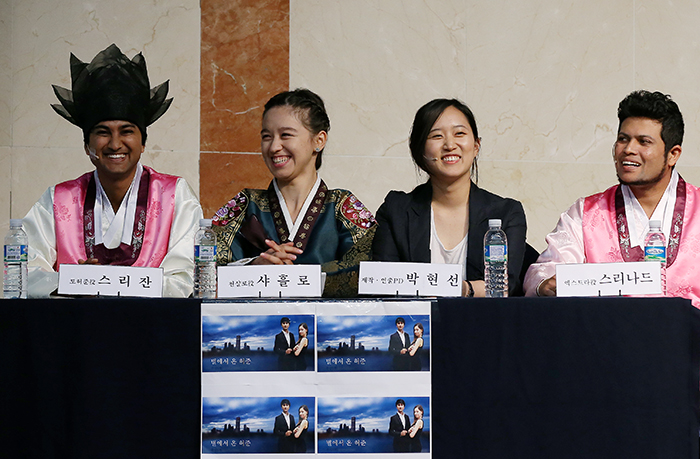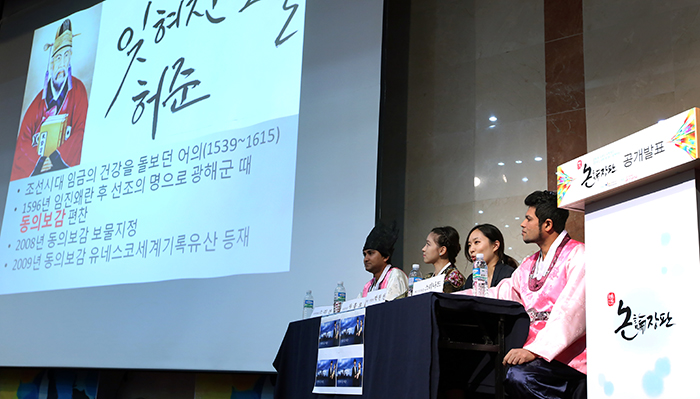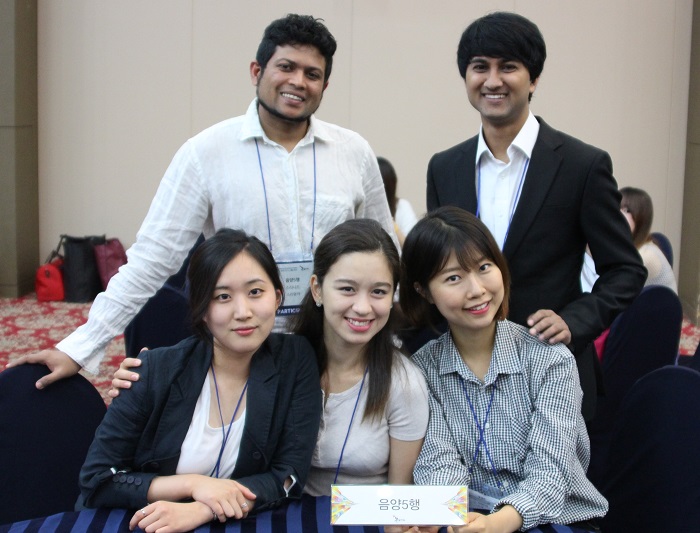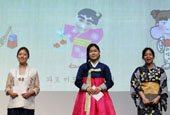
The Eumyangohhaeng team gives its presentation about royal physician Heo Jun (1539-1615) during 'Exploring Korean Humanities Together,' a cross-cultural presentation competition.
What would you think if youth from across the globe were to build friendships and share a conversation about Korean art, history and literature?
The Korean Culture and Information Service (KOCIS), part of the Ministry of Culture, Sports and Tourism and publisher of Korea.net, launched a series of presentations in 2014 called "Exploring Korean Humanities Together." It offers university students from around the world an opportunity to learn about Korean art, history, philosophy and literature. Marking its second year this year, there were 13 teams competing in the final rounds. The grand prize was awarded to the Eumyangohhaeng team, which means "The Yin, Yang and Five Elements," consisting of students from India, Sri Lanka, Uzbekistan and Korea.
The team members were Yuldasheva Shakhlo from Uzbekistan and currently in her fourth year at Kyung Hee University where she is majoring in trade. There was Kim Do-hee from Korea in her fourth year studying convention management at Kyung Hee University. Wijetunga Chandanashrinath was from Sri Lanka and is currently a graduate student in landscape architecture at the Graduate School of Environmental Studies. Kumar Srijan is from India and is currently a graduate student in Korean language education at Kyung Hee University and, finally, Park Hyun-seon from Korea is in her fourth year majoring in international studies at Korea University.
Their research topic was the Joseon royal physician Heo Jun (1539-1615) (허준, 許浚). He is well known in Korean history for his dedication to his kings. He wrote the "Mirror of Eastern Medicine" (Dongui Bogam, 동의보감, 東醫寶鑑) in 1613, one of the classics of Oriental medicine. To this day, the book is widely used in Korea and across East Asia, including Japan and mainland China.


Comprised of students from India, Sri Lanka, Uzbekistan and Korea, the Eumyangohhaeng team talks about a potential new soap opera called 'Heo Jun From the Star,' playing off the title of SBS's famous soap opera 'My Love From the Star.'
There are very few Koreans who are well-versed in the physician's life and in the details of his book. It was penned in classical Chinese characters, making it difficult for modern people to read. Also, Heo's descriptions aren't easy to follow. The Eumyangohhaeng team studied and researched Heo Jun and the "Mirror of Eastern Medicine," looking into every nook and cranny over the past three months. They met a countless number of times to discuss and update each other on their research.
In addition, the non-Korean members of the team studied similar figures in their own countries. The Uzbekistani member learned that there once existed an Avicenna, or Ibn Sina (c. 980-1037), who authored "The Canon of Medicine" in 1025. Shakhlo and Park learned about the similarities that the two figures share. They both produced the canon and presented the standard medical book for their times. One of the larger differences, however, was that Heo was faithful to his kings and to Confucian concepts whereas Avicenna gave up his reputation and social status to choose a life of freedom.

This year's grand prize at the 'Exploring Korean Humanities Together' contest goes to the Eumyangohhaeng team. The team consists of (from left, back row) Wijetunga Chandanashrinath from Sri Lanka and Kumar Srijan from India and (from left, front row) Park Hyun-seon from Korea, Yuldasheva Shakhlo from Uzbekistan and Kim Do-Hee from Korea.
The Eumyangohhaeng team also focused on Heo Jun's capacity for integrated thinking and great achievements in a diverse range of areas, including medicine, history, philosophy, the arts and literature. Kim Do-hee, one of the team members, said that, "I thought that his ability to integrate elements from diverse fields became the basis to build his concepts about the humanities that led him to develop an affection for people. These days, society is much more fierce and competitive. All we can do to survive is to not be competitive and to work for integration and cooperation with other people."
The team also criticized the modern influences of capitalism on medicine, saying that the medical practice has lost its function of saving lives and has, rather, changed to make one's life dead. Toward this conclusion, the team suggested that Heo Jun's teachings were handed down for many hundreds of years because they are based on an understanding and love for people, an important requirement and spirit for doctors from all over the world.
By Wi Tack-whan, Lee Seung-ah
Photos: Wi Tack-whan, Jeon Han
Korea.net Staff Writers
whan23@korea.kr
Heo Jun as seen by both Korean and non-Korean students
Compassion
"Unfortunately there are many people who die early in mountainous regions. We have many types of herbal medicines throughout the country, but people have a lack of knowledge about this. Now, I command you to record the name of the medicine when you classify it.
(From the introduction to the "Mirror of Eastern Medicine")
When Joseon people were sick, they had to starve. Many of them struggled with illnesses for a long time before they died because they weren't able to afford any medicine. Some of them performed ritual ceremonies praying to the gods of Heaven and Earth for the recovery of a family member. Heo Jun dedicated himself to helping the sick. He published the "Mirror of Eastern Medicine," which took him over 16 years to complete, based on his personal records of treating patients. He recorded the ways in which people treated themselves with herbal medicines, most of which was easily found in their daily lives.
The book consists of more than 2,000 symptoms, some 1,400 types of medicine to care for each illness and some 40,000 prescriptions, along with some hundreds of regimens and acupuncture techniques. It contains an extensive amount of information. It would be impossible to try every single treatment at least once during a lifetime. For each chapter, the physician provided information about how to treat similar illnesses with only the use of one medicine. Without compassion and sympathy for the people, he wouldn't have been able to come up with his masterpiece. The book upholds the values of training based on Taoism and emphasizes the importance of daily hygiene. He didn't pay attention to treatments per se, but stressed the importance of prevention. He suggested people have an understanding of the condition of their mind and soul before any illness breaks out.
Entertaining qualities
A married woman didn't want to eat any food, was always angry, swore a lot and showed a willingness to kill the people around her. Many doctors attempted to cure her disease, but were never successful. Heo Jun insisted that there is no medicine to cure her disease. He gave a prescription that had never been tried before. He brought two entertainers to perform in funny costumes. Watching their performances, the woman burst out laughing. The next day, she listened to him again and took part in a traditional ssireum wrestling match, bursting out again in laughter. Also, she was given a chance to spend time with two women who keep saying that the food is really delicious. The sick woman began to crave the things they were discussing. Then, only a few days later, the woman became less nervous, started eating a lot and recovered fully without any medicine. Later on, she gave birth to a baby, too. One of the most important qualities of a doctor is wit. Otherwise, how could they play it instantly by ear?
(From the Naegyeongpyeon of the "Mirror of Eastern Medicine" that deals with physiological functions and similar disorders in the internal organs. This section thoroughly explains the interactions among the traditional "five organs": the liver, lungs, kidneys, heart and spleen.)
One of Heo's greatest qualities was that he knew how to entertain people. He had wit, a sense of humor and was good at public speaking. He considered it very important to communicate and interact with his patients. He tried to gain an understanding of the patients' lives. His philosophy and love of humor are recorded in his book throughout a number of episodes and chapters.
Heo Jun was also an outstanding author. Medical books that only record the name of the illness, its symptoms and an appropriate treatment can never satisfy people's demand. The "Mirror of Eastern Medicine," however, is full of folktales that offer a glimpse into the medical environment and cultural elements of those times. Also, it adds fun with various types of writing styles, including poems, parallelism and a style that repeats the same sentence both at the beginning and end of the text. It has probably helped people gain a better understanding of medical information and made it easier to share it with other people. He also provided Korean names for a total of 637 types of herbal medicines and arranged the information in a way so that people can have easier access to it.
According to Ko Mi-suk, a journalist and critic of the classics, this system allows people to learn about prescriptions through the disease and, the other way around, ailments and symptoms through the prescriptions. The "Mirror of Eastern Medicine" has more than 100 pages of contents: internal bodily elements, external bodily elements, miscellaneous disorders and herbs, acupuncture, moxibustion and many others. This interesting book was made possible by his love for studying, his well-versed knowledge of the royal scriptures and his understanding of history as well as literature.
Self-belief
Heo Jun had a strong sense of self-belief. It can be seen from the meaning of the title "Mirror of Eastern Medicine." During ancient times, there were medical books that came from both northern and southern China, but he didn't accept them as medicine for Joseon. His new ambitious book title that he named was the "Mirror of Eastern Medicine."
Secondly, when the Gwanghaegun (r. 1608-1623) ruled and caught smallpox, Heo Jun volunteered his services and challenged himself to care for the monarch while other doctors didn't have the courage to do so. He tended to the ruler based on his knowledge and experience and never showed any signs of faltering. After he successfully treated the disease, he was given a high government post, but there were a number of people set against him. He always kept his own way and did his best as a physician. He was forced into exile for about one year and eight months at the age of 69 when King Seonjo died. During his exile, he finished authoring the book. That is another factor that gives us a glimpse into his determination and firm self-belief.m
